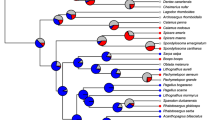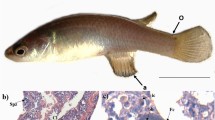Abstract
BY the publication in 1944 of a description of the gonads of Monopterus javanensis Lac. (Symbranchii; Teleostei), Liu1 has furnished new and interesting evidence concerning the mechanism of sex determination in the lower vertebrates, and has opened a fresh field for research into this subject. It is well known that, while the separate nature of the sexes is a general rule among fishes and amphibians, there are many species in which this separation is neither stable nor complete, and a great deal of research, both descriptive and experimental, has been devoted to the problem. In these circumstances it is exceptionally interesting to find that Monopterus is peculiar—and so far apparently unique—among vertebrates in being a true hermaphrodite, which functions as a female during the first half of its life and as a male during the second. It appears that this discovery may be one of considerable theoretical significance, and in order to place it into its proper context, the present state of our knowledge concerning sex determination in the lower vertebrates may be briefly summarized.
This is a preview of subscription content, access via your institution
Access options
Subscribe to this journal
Receive 51 print issues and online access
$199.00 per year
only $3.90 per issue
Buy this article
- Purchase on Springer Link
- Instant access to full article PDF
Prices may be subject to local taxes which are calculated during checkout
Similar content being viewed by others
References
Liu, C. K., Sinensia, 15, 1 (1944).
Witschi, E., Chapter 5 of "Sex and Internal Secretions" (London, 1932).
Witschi, E., Chapter 4 of the 2nd edition of "Sex and Internal Secretions" (Baltimore, 1939).
Bullough, W. S., J. Exp. Zool, 85, 475 (1940).
Crew, F. A. E., J. Genet., 11, 141 (1921).
Bullough, W. S., Proc. Leeds Phil Soc., 3, 638 (1939).
van Oordt, G. J., Z. mikr. anat. Forsch., 19, 1 (1929).
Witschi, E., Cold Spring Harbor Symp. Quant. Biol., 10, 145 (1942).
Author information
Authors and Affiliations
Rights and permissions
About this article
Cite this article
BULLOUGH*, W. Hermaphroditism in the Lower Vertebrates. Nature 160, 9–11 (1947). https://doi.org/10.1038/160009a0
Issue Date:
DOI: https://doi.org/10.1038/160009a0
This article is cited by
-
Sex determination mechanisms and sex control approaches in aquaculture animals
Science China Life Sciences (2022)
-
Cellular fate of intersex differentiation
Cell Death & Disease (2021)
-
Faster juvenile growth promotes earlier sex change in a protandrous hermaphrodite (barramundi Lates calcarifer)
Scientific Reports (2021)
-
Comparative Transcriptome Analysis Reveals Differentially Expressed Genes and Signaling Pathways Between Male and Female Red-Tail Catfish (Mystus wyckioides)
Marine Biotechnology (2019)
-
Jian-Kang Liu: A pioneer of sex determination studies in vertebrates
Protein & Cell (2016)
Comments
By submitting a comment you agree to abide by our Terms and Community Guidelines. If you find something abusive or that does not comply with our terms or guidelines please flag it as inappropriate.



